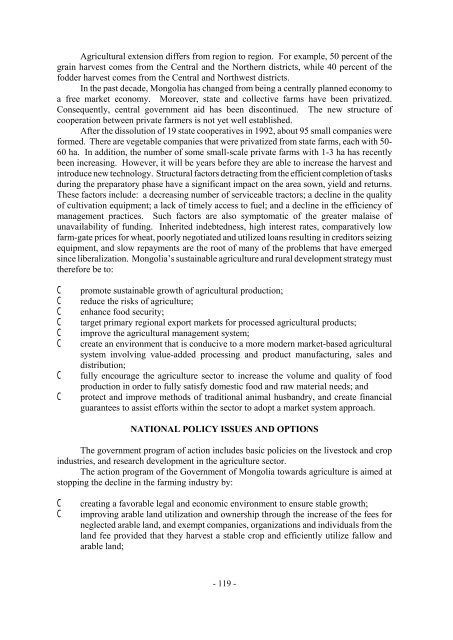Development of Agribusiness Enterprises - Asian Productivity ...
Development of Agribusiness Enterprises - Asian Productivity ...
Development of Agribusiness Enterprises - Asian Productivity ...
Create successful ePaper yourself
Turn your PDF publications into a flip-book with our unique Google optimized e-Paper software.
Agricultural extension differs from region to region. For example, 50 percent <strong>of</strong> the<br />
grain harvest comes from the Central and the Northern districts, while 40 percent <strong>of</strong> the<br />
fodder harvest comes from the Central and Northwest districts.<br />
In the past decade, Mongolia has changed from being a centrally planned economy to<br />
a free market economy. Moreover, state and collective farms have been privatized.<br />
Consequently, central government aid has been discontinued. The new structure <strong>of</strong><br />
cooperation between private farmers is not yet well established.<br />
After the dissolution <strong>of</strong> 19 state cooperatives in 1992, about 95 small companies were<br />
formed. There are vegetable companies that were privatized from state farms, each with 50-<br />
60 ha. In addition, the number <strong>of</strong> some small-scale private farms with 1-3 ha has recently<br />
been increasing. However, it will be years before they are able to increase the harvest and<br />
introduce new technology. Structural factors detracting from the efficient completion <strong>of</strong> tasks<br />
during the preparatory phase have a significant impact on the area sown, yield and returns.<br />
These factors include: a decreasing number <strong>of</strong> serviceable tractors; a decline in the quality<br />
<strong>of</strong> cultivation equipment; a lack <strong>of</strong> timely access to fuel; and a decline in the efficiency <strong>of</strong><br />
management practices. Such factors are also symptomatic <strong>of</strong> the greater malaise <strong>of</strong><br />
unavailability <strong>of</strong> funding. Inherited indebtedness, high interest rates, comparatively low<br />
farm-gate prices for wheat, poorly negotiated and utilized loans resulting in creditors seizing<br />
equipment, and slow repayments are the root <strong>of</strong> many <strong>of</strong> the problems that have emerged<br />
since liberalization. Mongolia’s sustainable agriculture and rural development strategy must<br />
therefore be to:<br />
C promote sustainable growth <strong>of</strong> agricultural production;<br />
C reduce the risks <strong>of</strong> agriculture;<br />
C enhance food security;<br />
C target primary regional export markets for processed agricultural products;<br />
C improve the agricultural management system;<br />
C create an environment that is conducive to a more modern market-based agricultural<br />
system involving value-added processing and product manufacturing, sales and<br />
distribution;<br />
C fully encourage the agriculture sector to increase the volume and quality <strong>of</strong> food<br />
production in order to fully satisfy domestic food and raw material needs; and<br />
C protect and improve methods <strong>of</strong> traditional animal husbandry, and create financial<br />
guarantees to assist efforts within the sector to adopt a market system approach.<br />
NATIONAL POLICY ISSUES AND OPTIONS<br />
The government program <strong>of</strong> action includes basic policies on the livestock and crop<br />
industries, and research development in the agriculture sector.<br />
The action program <strong>of</strong> the Government <strong>of</strong> Mongolia towards agriculture is aimed at<br />
stopping the decline in the farming industry by:<br />
C creating a favorable legal and economic environment to ensure stable growth;<br />
C improving arable land utilization and ownership through the increase <strong>of</strong> the fees for<br />
neglected arable land, and exempt companies, organizations and individuals from the<br />
land fee provided that they harvest a stable crop and efficiently utilize fallow and<br />
arable land;<br />
- 119 -
















